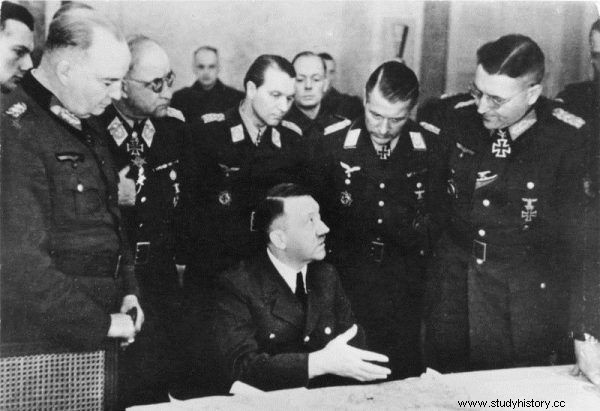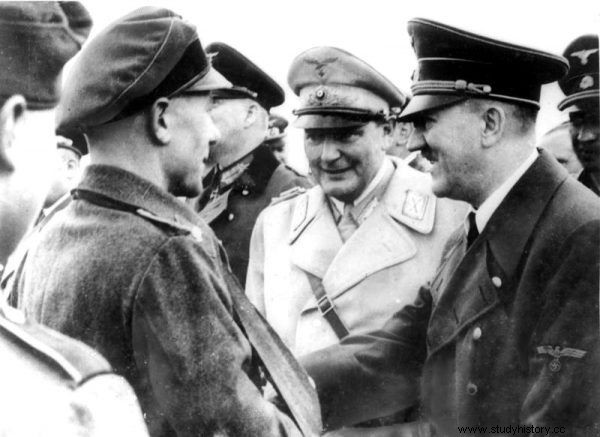He was seen in Argentina and several other countries. It has been speculated that he escaped to a secret Nazi base in Antarctica or took refuge aboard a submarine. Even the FBI was investigating his disappearance. Is it possible that Hitler did not die in the last days of the war?
On April 30, 1945, Russian artillery was heard even on the lowest level of Hitler's bunker in the very center of Berlin. The Führer himself already knew that these were the last hours of the thousand-year-old Reich. This creature only survived for a little over a decade, and is now crumbling to dust with its creator.
Could a man who, having devoted his entire adult life to one idea, faced not only death, but also the prospect of destroying all the fruits of his work, want to cheat destiny? The answer to this question only seems simple. After all, it can be assumed that any normal person would try to escape the impending doom.
The problem is that the leader of the Third Reich was by no means typical. It is not even about his possible mental illness, about which some researchers speculate, but about his specific perception of reality. It was he who made unacceptable to the Nazi leader any hoaxes simulating his death . The only way out he saw before him was suicide.

The press quickly began celebrating Hitler's death. But is it right?
The corporal who did not bow to bullets
Virtually all theories assuming that Hitler escaped from burning Berlin ignore this characteristic. The Führer was not an opportunist, but rather a fanatic. He saw in himself the chosen one of destiny. Earlier, even during World War I, he showed bravado and risked death more than once, fulfilling his duties. He was even decorated twice, but consistently refused to accept promotion. After he was wounded and transported to the rear, he persuaded his commanders to send him back to the front.
He wanted to fight to the end. He accepted the ceasefire in 1918 indignantly. He was in hospital at the time, blinded after a British gas attack. It was there that he supposedly decided to become a politician and transform Germany so that the "drama of surrender and humiliation" would never be repeated again.
Persistence and pursuit of the goal at all costs characterized him to the end. These features, which often caused conflicts with the environment, also influenced his recent choices. However, not everyone believed it.

The article was inspired by the book by Christopher Macht "Hitler's Confession 2. A Honest Conversation 20 Years After the War" , published by Bellona.
Tunnel, plane and submarine - Adolf running away
The number of theories about the alleged flight of the dictator from Berlin is really impressive. And it keeps growing. And the further away from the war, witnesses and documents, the more fantastic the proposed solutions become. Some of their authors maintain the appearance of a historical investigation; others openly use literary fiction.
One of the popular concepts is that Hitler and Ewa Braun escaped from besieged Berlin through a secret tunnel . He then boarded a plane that took him to Denmark. Then, already on board the submarine, he made it to South America, the favorite part of the world by the Nazis.
This theory is based on an often cited journalistic note from 1949. It stated that the Luftwaffe pilot Peter Baumgart, decorated with the Iron Cross air ace with well over a hundred downed planes on his account, testified in court that he was the one piloting the machine with the Führer on board. For the flight, he allegedly collected a check for 20,000 marks from the chief.

Hitler was persuaded to flee by many of his associates. Photo from 1945.
Unfortunately, the "researchers" using the note do not mention that Baumgart cannot be found in any list of Luftwaffe members. They also do not inform that the pilot filed this statement with a Polish court, accused of being a crew member of the concentration camp in Auschwitz. Hitler's "savior", considered insane, was sentenced to 5 years imprisonment. He was released in 1951. Later, he never told anyone else the story of the spectacular escape of the Nazi leader.
We will build the Fourth Reich, that is, a leader in the legs
But let's ask otherwise. Was Hitler able to escape? Certainly yes. Even in the last days of the war, he was persuaded to do so by his close associates and fanatical followers. The talented pilot Hanna Reitsch proposed at the end of April 1945 that she would take him from Berlin in her little plane. If Hitler agreed, the plan might work.
The commander's right hand, Martin Bormann, also tried to persuade him to evacuate. However, despite his visions of building a new Reich and continuing the struggle, he consistently refused. He realized that behind most of these requests there was a fear for their own positions.

Hitler was able to escape. But would he really like to use it?
Therefore, at the end of April 30, 1945, around 2.30 pm, the Führer went with his newly wedded wife to his room. Less than an hour later, a single pistol shot rang out. When the door to the room was opened, the bride and groom were lying on the couch. Hitler shot himself while gnawing a cyanide capsule, and Eve Braun poisoned herself.
The bodies were taken outside the bunker, poured over with gasoline and set on fire. The remains were then hastily buried in a shallow grave where two dogs had previously been buried - Hitler's beloved shepherd dog Blondi and her puppy Wulf. Both were killed on the orders of the owner.
The truth revealed years later
The fact that almost no trace of the dictator's body was left has fueled conspiracy theories. Fortunately, in this case “almost” does make a real difference.
After taking Berlin, the Russians quickly collected eyewitness testimony and dug up the burnt remains of the Hitler state. The Führer was easily identified on the basis of the preserved lower jaw and secured dental records. However, this information was not disseminated. All because Stalin wanted to maintain the uncertainty and the atmosphere of danger of a possible return of the Nazis . The Russian bluff worked, even though the British specialist sent to the site, based on independent sources, also confirmed the death of the leader of the Third Reich. Even the Americans were fooled and the myth started to live a life of its own.

The article was inspired by the book by Christopher Macht "Hitler's Confession 2. A Honest Conversation 20 Years After the War" , published by Bellona.
The case was complicated by the fact that, due to a lack of evidence, the German courts could not confirm the tyrant's death. Meanwhile, reports were pouring in from all over the world that he had been spotted. Various places where he allegedly had been hiding were given. He was claimed to be a wealthy industrialist in Argentina, another time that he owned a hotel in Switzerland. It was even suspected that he might work as a waiter in Florida! The press loved such stories and no one was anxious to find out the truth.
Only in the 1990s, after the collapse of the Soviet Union, some researchers managed to find secret documentation in Russia. Even the remains preserved there were discovered - a fragment of the skull with a visible bullet hole and a fragment of the jaw.
Controversy has arisen over these finds. One American researcher stated that the skull bone probably belonged to a woman. Ultimately, however, in April 2018, the day before Hitler's birthday, a prestigious medical journal published extensive research results from a team of French scientists that dispelled all doubts. Although the sex of the deceased cannot be definitively determined from a fragment of the skull that has been shot through, the jaw has provided more information. This one certainly belonged to Adolf Hitler. The researchers even managed to confirm the testimony of witnesses that the chief also chewed a cyanide capsule.

The Russians, shortly after entering Berlin, unearthed the remains of the Hitler state, buried near the bunker where they spent their last days. Stalin, however, decided not to disseminate this information.
Will this expert report finally close the subject of Hitler's death? Certainly not. Nowadays, hardly anyone bothers with facts or verification of sources. In addition, books exploring alternative history are still very popular:what if the leader of the Third Reich actually escaped?
So could Hitler survive the war? Yes, but he certainly didn't. And you didn't really have to wait for his remains to be found to know that. The main character traits of the leader of the Third Reich - courage, fanaticism and stubbornness combined with a huge dose of megalomania - simply would not allow him to pretend to be a corpse and hide in more or less exotic countries.
Inspiration:
The article was inspired by the novel by Christopher Macht Confession of Hitler 2. A Honest Conversation 20 Years After the War , published by the Bellona publishing house.
Buy the book cheaper on the Publisher's website:

